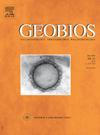Palaehoplophorini glyptodonts (Xenarthra, Glyptodontidae) from the Puerto Madryn Formation (Late Miocene), Argentine Patagonia: Diversity and biochronological implications in southern South America
IF 1.6
4区 地球科学
Q2 PALEONTOLOGY
引用次数: 0
Abstract
Palaehoplophorini is a poorly known lineage of glyptodonts that appeared during the Middle Miocene in Patagonia. Their diversity is considered low with respect to other glyptodont groups, including only two well-characterized species from the Middle-Late Miocene of Patagonia (ca. 12 Ma): Palaehoplophorus meridionalis and Palaehoplophoroides rothi. The putative Late Miocene Palaehoplophorini Palaehoplophorus antiquus and Aspidocalyptus castroi from the Mesopotamian and Pampean regions, respectively, were defined based on fragmentary materials without relevant diagnostic characters. Here, we describe several Late Miocene (ca. 9.4 Ma) Palaehoplophorini remains coming from the upper levels of the Puerto Madryn Formation (Península Valdés, Chubut Province, Argentina). Material includes carapace osteoderms, caudal rings, and tube fragments, all assigned to Palaehoplophorini. A right femur one-third larger than that of Kelenkura castroi (Chasicoan Stage/Age) was also identified, suggesting an estimated body mass of ca. 320 kg. These fossil remains confirm the persistence of Palaehoplophorini during the Late Miocene, at least in Patagonia. Our analysis also discards the Pampean region as a “refuge” for the last Palaehoplophorini as it was previously proposed. Lastly, anatomical comparisons reflect a correlation between body mass and latitudinal distribution of late Tortonian glyptodonts in South America, with a size decrease towards low latitudes.
阿根廷巴塔哥尼亚Puerto Madryn组(晚中新世)的Palaehoplophorini雕齿兽(Xenarthra,雕齿兽科):南美洲南部的多样性及其生物年代学意义
古hopplophorini是一个鲜为人知的雕齿兽谱系,出现在中新世中期的巴塔哥尼亚。与其他雕齿兽类群相比,它们的多样性被认为较低,包括来自巴塔哥尼亚中新世中晚期(约12 Ma)的两个特征良好的物种:Palaehoplophorus meridionalis和Palaehoplophoroides rothi。推测的晚中新世古hopplophorini古hopplophorus antius和来自美索不达米亚地区的castidocalyptus castroi是基于碎片材料而没有相关的诊断特征。本文描述了几个晚中新世(约9.4 Ma)的古hoplophorini化石,它们来自Puerto Madryn组(Península vald,阿根廷Chubut省)的上层。材料包括甲壳骨皮、尾环和管碎片,都属于古hopplophorini。还发现了比Kelenkura castroi (Chasicoan阶段/年龄)大三分之一的右股骨,表明估计体重约为320公斤。这些化石遗迹证实了古hopplophorini在晚中新世的持续存在,至少在巴塔哥尼亚。我们的分析也抛弃了潘潘亚地区是最后一个古hopplophorini的“避难所”,正如之前提出的那样。最后,解剖比较反映了南美洲晚托尔顿期雕齿兽的体重与纬度分布之间的相关性,体型向低纬度方向减小。
本文章由计算机程序翻译,如有差异,请以英文原文为准。
求助全文
约1分钟内获得全文
求助全文
来源期刊

Geobios
地学-古生物学
CiteScore
3.30
自引率
6.20%
发文量
28
审稿时长
6-12 weeks
期刊介绍:
Geobios publishes bimonthly in English original peer-reviewed articles of international interest in any area of paleontology, paleobiology, paleoecology, paleobiogeography, (bio)stratigraphy and biogeochemistry. All taxonomic groups are treated, including microfossils, invertebrates, plants, vertebrates and ichnofossils.
Geobios welcomes descriptive papers based on original material (e.g. large Systematic Paleontology works), as well as more analytically and/or methodologically oriented papers, provided they offer strong and significant biochronological/biostratigraphical, paleobiogeographical, paleobiological and/or phylogenetic new insights and perspectices. A high priority level is given to synchronic and/or diachronic studies based on multi- or inter-disciplinary approaches mixing various fields of Earth and Life Sciences. Works based on extant data are also considered, provided they offer significant insights into geological-time studies.
 求助内容:
求助内容: 应助结果提醒方式:
应助结果提醒方式:


